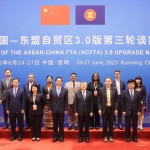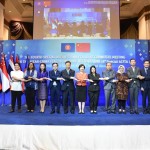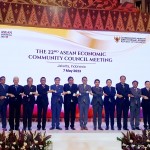Tổng số bài đăng 465.
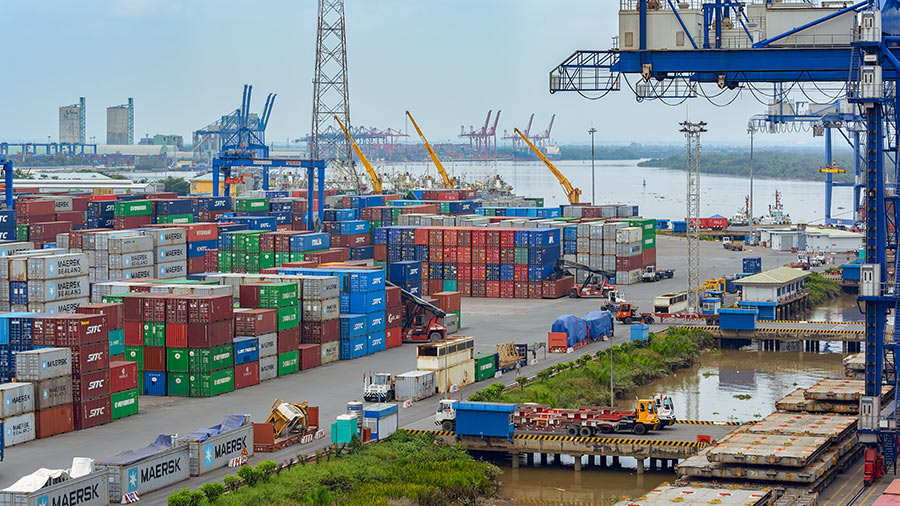 Vietnam has emerged as a prime location for sourcing for several reasons such as competitive labor, political stability, low business expenses, and a growing consumer market. However, choosing a sourcing partner can be daunting for first-time investors. Vietnam Briefing outlines the optimal search criteria a company should utilize when choosing a sourcing partner in Vietnam.
Vietnam has emerged as a prime location for sourcing for several reasons such as competitive labor, political stability, low business expenses, and a growing consumer market. However, choosing a sourcing partner can be daunting for first-time investors. Vietnam Briefing outlines the optimal search criteria a company should utilize when choosing a sourcing partner in Vietnam.
Finding the right sourcing partners to work with can be a complex and stress-inducing process. Before interviewing every possible partner, it is important for a company to clearly define what specifically they are looking for in a sourcing partner and what they expect from the area where that partner is located. Important specifics for most companies would include:
- What type of products are being sourced;
- The level of experience required (technical, manufacturing capabilities, and so on);
- Capital ability of the potential partner;
- Relevant state/local regulation;
- Existence/quality of supporting industries (how will the supply chain work?); and
- Quality of infrastructure/transportation systems in the area where the potential partner is located.
Additionally, a foreign company must decide on its entry strategy into Vietnam, as well as what its long-term strategy will be. Does it plan to hire a lot of employees or just a few at first? Is it possible to handle sourcing operations without a footprint within the country, or will the company have to open an office on the ground? Where will the finished products be transported to?
Searching for sourcing partners
There are a variety of helpful channels for finding sourcing partners, these include:
- Online databases;
- Official government databases listed by commercial chambers of commerce;
- Associations of planned products;
- Professional sourcing agents;
- Trade fairs; and
- Information provided by industrial parks and economic zones.
Besides these, there are other ways of finding a sourcing partner such as through personal introductions, client referrals, networking events, and other types of internal connections.
Screening potential partners
Once a list of potential candidates has been created, it is then time to proceed to the next stage of the process and begin the screening of the different companies. This stage often requires visiting the potential partner’s factories so that a clearer idea of their capabilities can be formulated.
Due to the time involved, not to mention overcoming barriers such as language, many companies tend to hire a professional services firm to perform the screening process for them and to identify the best candidates to act as sourcing partners.
Sourcing companies are different from trading, where they former provide all the required information about the manufacturers, company profiles, production capacity, sample cost, and so on. Further, sourcing companies can support the investor with a factory tour, supplier background checks, or even testing and logistics via a third party. Some companies will offer these services as an all-inclusive package, while others charge based on project milestones or individual services.
It should also be taken into consideration that, due to Vietnam’s legal rules, a company is not locked into the initial decision that it makes. These laws allow business entities to change the scale of their operations and change their legal form, as well as allowing them to do any other actions which are entitled by law. In short, the scale of business is not fixed and can be altered according to the needs of the investors.
Choosing a location
Once the basic specifics of a sourcing partner have been laid out by the company, the next step is to begin identifying which parts of the country are best suited for the needs of the company.
What follows below is a detailed breakdown of the key areas throughout the country for a variety of common business products. It is also important to take note of the location of the various industrial parks, high-tech parks, and export processing zones. Before any sourcing decision can be made, it is vital to thoroughly think through where it is best to strategically locate your business and where your sourcing partner should be located.
Ideally, a sourcing operation should be located in an area that enjoys favorable taxation (such as an industrial zone), is well placed to acquire the raw materials needed for production, and is positioned in an area well suited for export, for example, close to a shipping port.
Developing your business entity for your sourcing platform
Regardless of whether a foreign company is involved in manufacturing, assembling, purchasing, or designing products in Vietnam, each business will have to develop its own individual model for sourcing the necessary goods, component parts, and raw materials that will determine their short or long-term success. Making the right decision is crucial since any misstep could be very costly.
Ultimately, businesses sourcing products from Vietnam successfully will reach a trigger point where they will need to establish a permanent entity or base full-time employees in Vietnam to carry on work such as supplier searches, price negotiations, export formalities, quality control supervision, and so on. To do this, investors can either form a representative office or a limited liability company to create a sourcing platform in Vietnam. For import and export activities, the investor will be required to form a trading company.
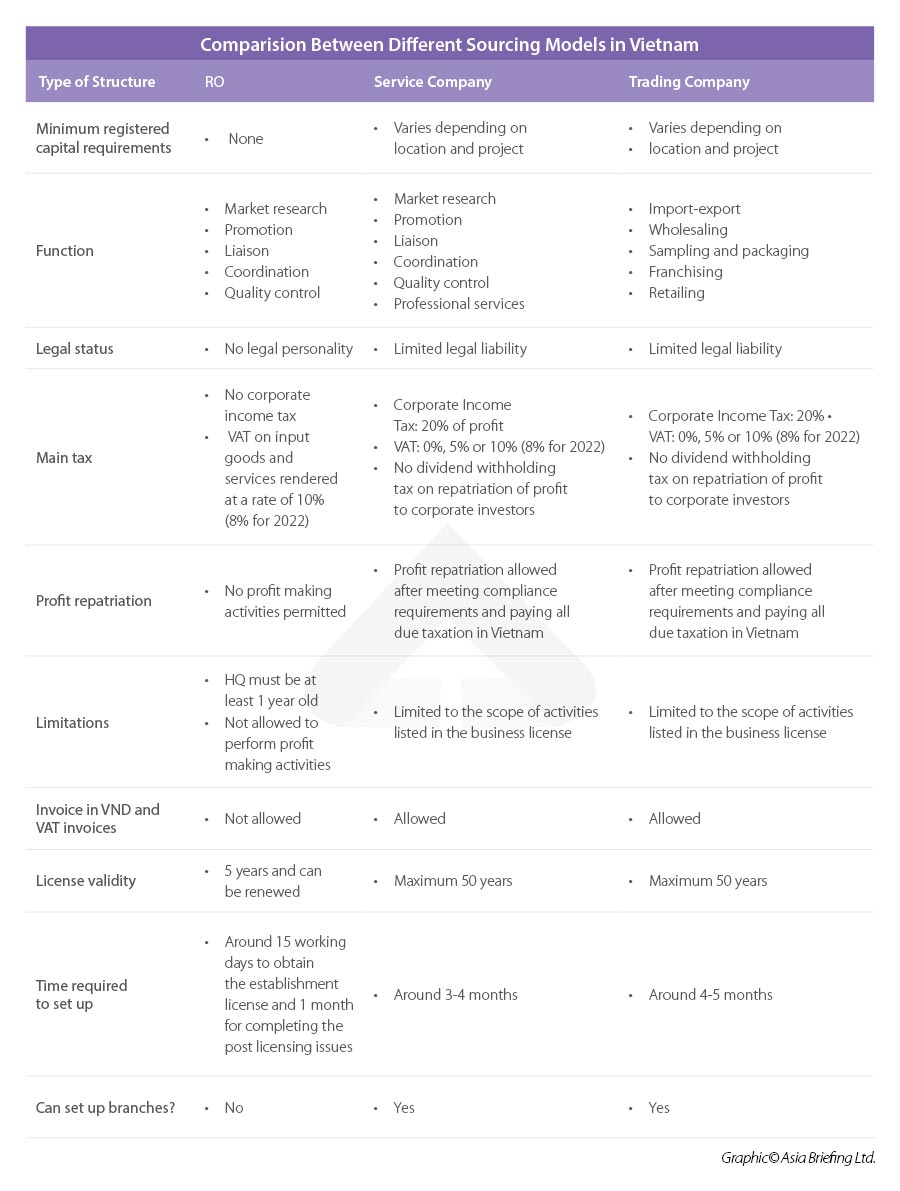
While any of the legal structures mentioned can be used as a necessary building block to a successful Vietnam sourcing strategy, it can often be challenging for companies (particularly those new to Vietnam) to decide on the optimal solutions needed to support their mainland sourcing activities. With so many quality control and trading agents available offering one-stop sourcing services and B2B online platforms that allow direct contact with suppliers, many will argue that it could be just as effective to utilize a subcontracting agreement and intermediate parties to get the job done.
Although this can be true and is a perfectly workable option, to be more competitive in global supply chains many SMEs now require an on-the-ground presence either to gain better control of their supply chain, or to be able to continue servicing their international customers who have also entered the Vietnamese market.
Therefore, to select the most suitable business model, it is important to carefully balance the capability of each option against the primary needs of the sourcing activities.
Takeaways
There is no single successful sourcing strategy, and your business can be structured as simply as an RO or as elaborately as a multinational sourcing plan that uses a combination of the mentioned legal structures. The most appropriate strategy may be a progression between the different models over time. Regardless of the strategy, to ensure that the chosen structure adds sufficient value, parent companies will need to regularly monitor the performance of their sourcing offices and continually develop existing and new supplier sources to remain competitive.
Source: Vietnam Briefing







